CHRYSLER CROSSFIRE 2008 1.G Owners Manual
Manufacturer: CHRYSLER, Model Year: 2008, Model line: CROSSFIRE, Model: CHRYSLER CROSSFIRE 2008 1.GPages: 358, PDF Size: 4.7 MB
Page 131 of 358
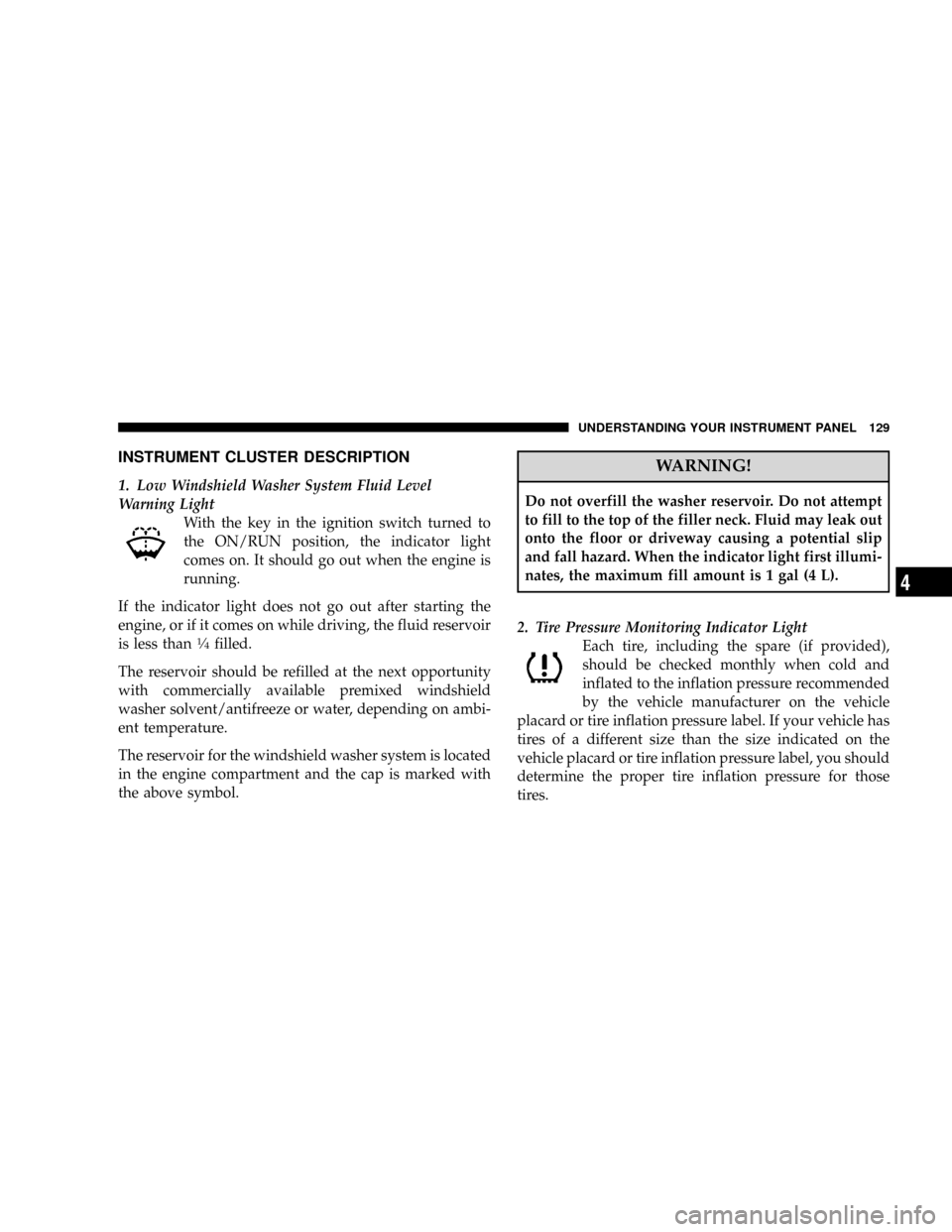
INSTRUMENT CLUSTER DESCRIPTION
1. Low Windshield Washer System Fluid Level
Warning Light
With the key in the ignition switch turned to
the ON/RUN position, the indicator light
comes on. It should go out when the engine is
running.
If the indicator light does not go out after starting the
engine, or if it comes on while driving, the fluid reservoir
is less than
1¤4filled.
The reservoir should be refilled at the next opportunity
with commercially available premixed windshield
washer solvent/antifreeze or water, depending on ambi-
ent temperature.
The reservoir for the windshield washer system is located
in the engine compartment and the cap is marked with
the above symbol.
WARNING!
Do not overfill the washer reservoir. Do not attempt
to fill to the top of the filler neck. Fluid may leak out
onto the floor or driveway causing a potential slip
and fall hazard. When the indicator light first illumi-
nates, the maximum fill amount is 1 gal (4 L).
2. Tire Pressure Monitoring Indicator Light
Each tire, including the spare (if provided),
should be checked monthly when cold and
inflated to the inflation pressure recommended
by the vehicle manufacturer on the vehicle
placard or tire inflation pressure label. If your vehicle has
tires of a different size than the size indicated on the
vehicle placard or tire inflation pressure label, you should
determine the proper tire inflation pressure for those
tires.
UNDERSTANDING YOUR INSTRUMENT PANEL 129
4
Page 132 of 358

As an added safety feature, your vehicle has been
equipped with a tire pressure monitoring system (TPMS)
that illuminates a low tire pressure telltale when one or
more of your tires is significantly under-inflated. Accord-
ingly, when the low tire pressure telltale illuminates, you
should stop and check your tires as soon as possible, and
inflate them to the proper pressure. Driving on a signifi-
cantly under-inflated tire causes the tire to overheat and
can lead to tire failure. Under-inflation also reduces fuel
efficiency and tire tread life, and may affect the vehicle's
handling and stopping ability.
Please note that the TPMS is not a substitute for proper
tire maintenance, and it is the driver 's responsibility to
maintain correct tire pressure, even if under-inflation has
not reached the level to trigger illumination of the TPMS
low tire pressure telltale.Your vehicle has also been equipped with a TPMS
malfunction indicator to indicate when the system is not
operating properly. The TPMS malfunction indicator is
combined with the low tire pressure telltale. When the
system detects a malfunction, the telltale will flash for
approximately one minute and then remain continuously
illuminated. This sequence will continue upon subse-
quent vehicle start-ups as long as the malfunction exists.
When the malfunction indicator is illuminated, the sys-
tem may not be able to detect or signal low tire pressure
as intended. TPMS malfunctions may occur for a variety
of reasons, including the installation of replacement or
alternate tires or wheels on the vehicle that prevent the
TPMS from functioning properly. Always check the
TPMS malfunction telltale after replacing one or more
tires or wheels on your vehicle to ensure that the replace-
ment or alternate tires and wheels allow the TPMS to
continue to function properly.
130 UNDERSTANDING YOUR INSTRUMENT PANEL
Page 133 of 358
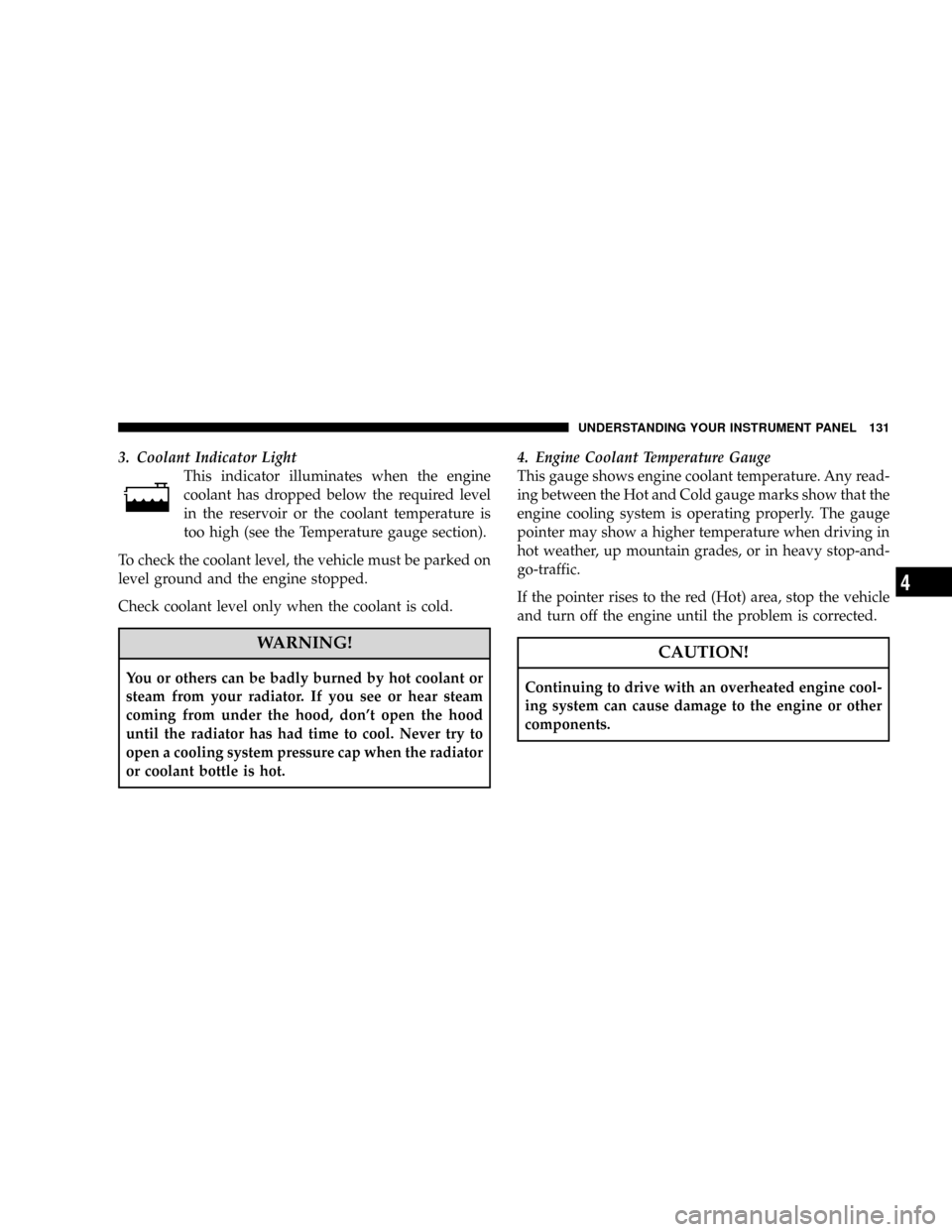
3. Coolant Indicator Light
This indicator illuminates when the engine
coolant has dropped below the required level
in the reservoir or the coolant temperature is
too high (see the Temperature gauge section).
To check the coolant level, the vehicle must be parked on
level ground and the engine stopped.
Check coolant level only when the coolant is cold.
WARNING!
You or others can be badly burned by hot coolant or
steam from your radiator. If you see or hear steam
coming from under the hood, don't open the hood
until the radiator has had time to cool. Never try to
open a cooling system pressure cap when the radiator
or coolant bottle is hot.4. Engine Coolant Temperature Gauge
This gauge shows engine coolant temperature. Any read-
ing between the Hot and Cold gauge marks show that the
engine cooling system is operating properly. The gauge
pointer may show a higher temperature when driving in
hot weather, up mountain grades, or in heavy stop-and-
go-traffic.
If the pointer rises to the red (Hot) area, stop the vehicle
and turn off the engine until the problem is corrected.
CAUTION!
Continuing to drive with an overheated engine cool-
ing system can cause damage to the engine or other
components.
UNDERSTANDING YOUR INSTRUMENT PANEL 131
4
Page 134 of 358
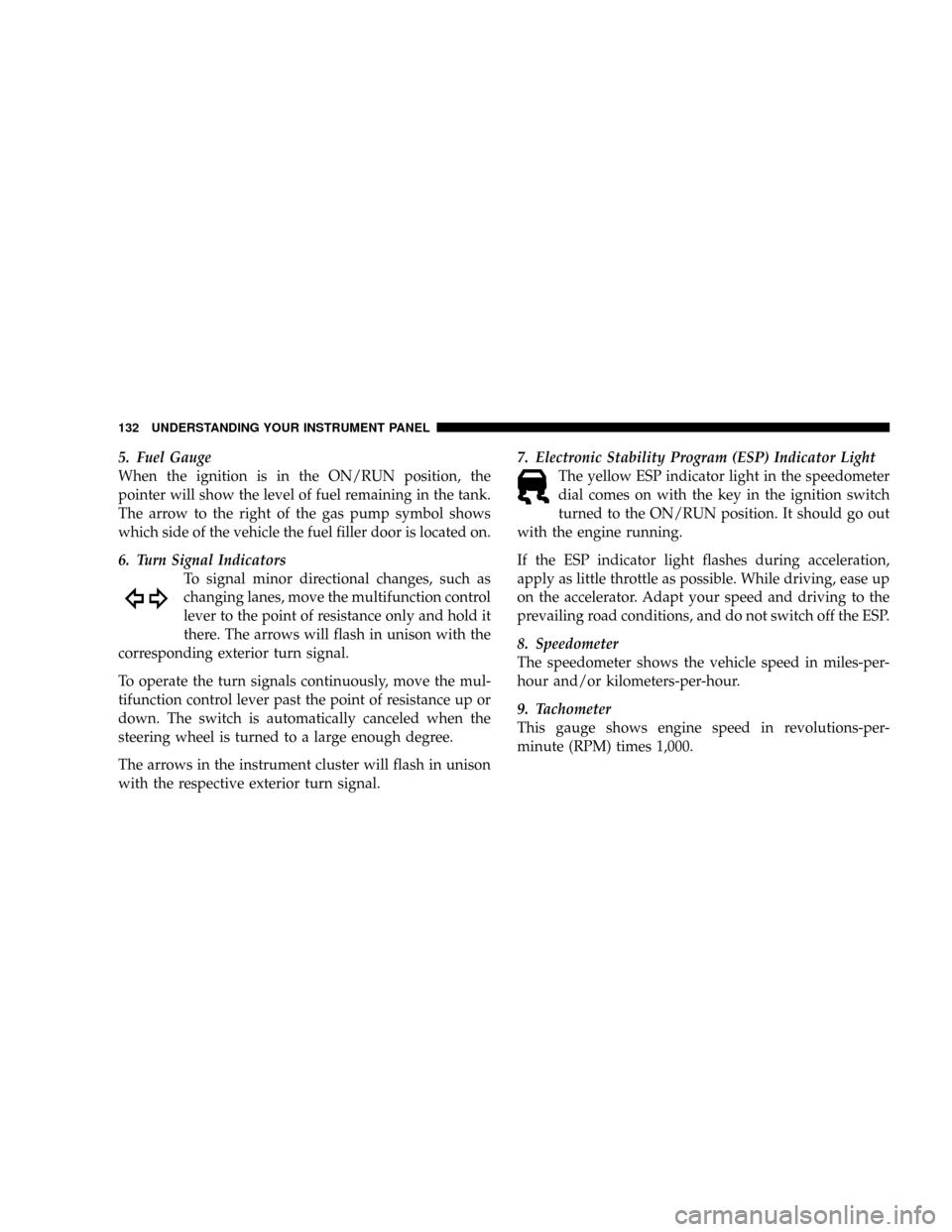
5. Fuel Gauge
When the ignition is in the ON/RUN position, the
pointer will show the level of fuel remaining in the tank.
The arrow to the right of the gas pump symbol shows
which side of the vehicle the fuel filler door is located on.
6. Turn Signal Indicators
To signal minor directional changes, such as
changing lanes, move the multifunction control
lever to the point of resistance only and hold it
there. The arrows will flash in unison with the
corresponding exterior turn signal.
To operate the turn signals continuously, move the mul-
tifunction control lever past the point of resistance up or
down. The switch is automatically canceled when the
steering wheel is turned to a large enough degree.
The arrows in the instrument cluster will flash in unison
with the respective exterior turn signal.7. Electronic Stability Program (ESP) Indicator Light
The yellow ESP indicator light in the speedometer
dial comes on with the key in the ignition switch
turned to the ON/RUN position. It should go out
with the engine running.
If the ESP indicator light flashes during acceleration,
apply as little throttle as possible. While driving, ease up
on the accelerator. Adapt your speed and driving to the
prevailing road conditions, and do not switch off the ESP.
8. Speedometer
The speedometer shows the vehicle speed in miles-per-
hour and/or kilometers-per-hour.
9. Tachometer
This gauge shows engine speed in revolutions-per-
minute (RPM) times 1,000.
132 UNDERSTANDING YOUR INSTRUMENT PANEL
Page 135 of 358

The red markings on the tachometer indicate excessive
engine speed. Ease off on the accelerator before reaching
the red area.
10. Brake System Warning Light
The dual brake system provides a reserve brak-
ing capability if a failure occurs in a portion of
the hydraulic system.
This light monitors both the brake fluid level and the
parking brake. If the light comes on, it indicates either
that the parking brake is on or there is a low fluid level in
the brake master cylinder. Since this vehicle is equipped
with Anti-Lock Brakes (ABS), the brake light may also
indicate reduced braking performance due to the loss of
electronic brake proportioning. If the parking brake is off
and the light remains on, have the brake system in-
spected as soon as possible.The warning light should be checked frequently to assure
that it is operating properly. This can be done by turning
the ignition switch to START. The light should come on.
If the red brake light does not come on when the ignition
is turned to the ON/RUN position, have the brake
warning light repaired promptly.
WARNING!
Driving a vehicle with the brake light on is danger-
ous. Part of the brake system may have failed. It will
take longer to stop the vehicle. You could have an
accident. Have the vehicle checked immediately.
NOTE:This light shows only that the parking brake is
on. It does not show the degree of brake application.
The brake warning light will come on if the ABS light is
not functioning and there is an ABS system malfunction.
UNDERSTANDING YOUR INSTRUMENT PANEL 133
4
Page 136 of 358
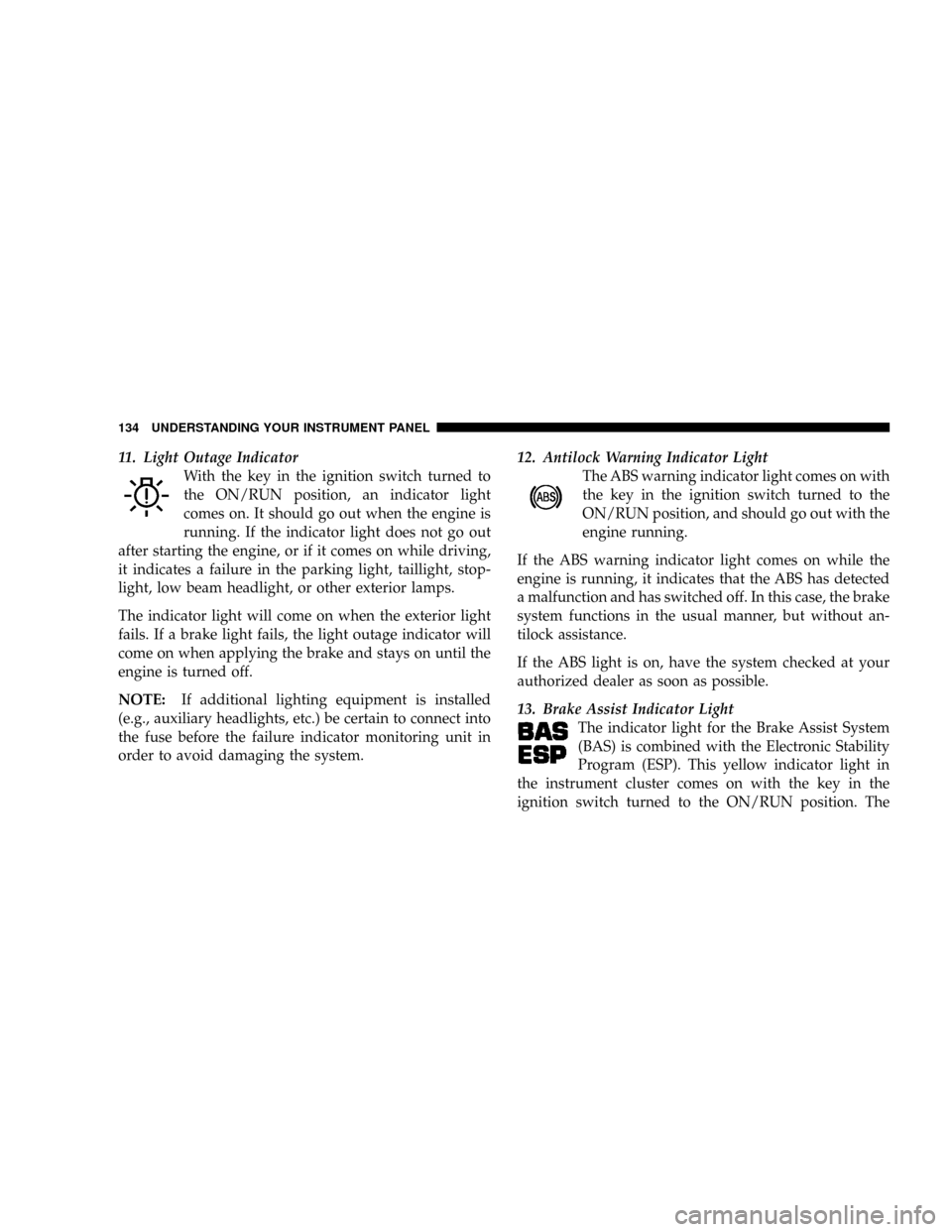
11. Light Outage Indicator
With the key in the ignition switch turned to
the ON/RUN position, an indicator light
comes on. It should go out when the engine is
running. If the indicator light does not go out
after starting the engine, or if it comes on while driving,
it indicates a failure in the parking light, taillight, stop-
light, low beam headlight, or other exterior lamps.
The indicator light will come on when the exterior light
fails. If a brake light fails, the light outage indicator will
come on when applying the brake and stays on until the
engine is turned off.
NOTE:If additional lighting equipment is installed
(e.g., auxiliary headlights, etc.) be certain to connect into
the fuse before the failure indicator monitoring unit in
order to avoid damaging the system.12. Antilock Warning Indicator Light
The ABS warning indicator light comes on with
the key in the ignition switch turned to the
ON/RUN position, and should go out with the
engine running.
If the ABS warning indicator light comes on while the
engine is running, it indicates that the ABS has detected
a malfunction and has switched off. In this case, the brake
system functions in the usual manner, but without an-
tilock assistance.
If the ABS light is on, have the system checked at your
authorized dealer as soon as possible.
13. Brake Assist Indicator Light
The indicator light for the Brake Assist System
(BAS) is combined with the Electronic Stability
Program (ESP). This yellow indicator light in
the instrument cluster comes on with the key in the
ignition switch turned to the ON/RUN position. The
134 UNDERSTANDING YOUR INSTRUMENT PANEL
Page 137 of 358
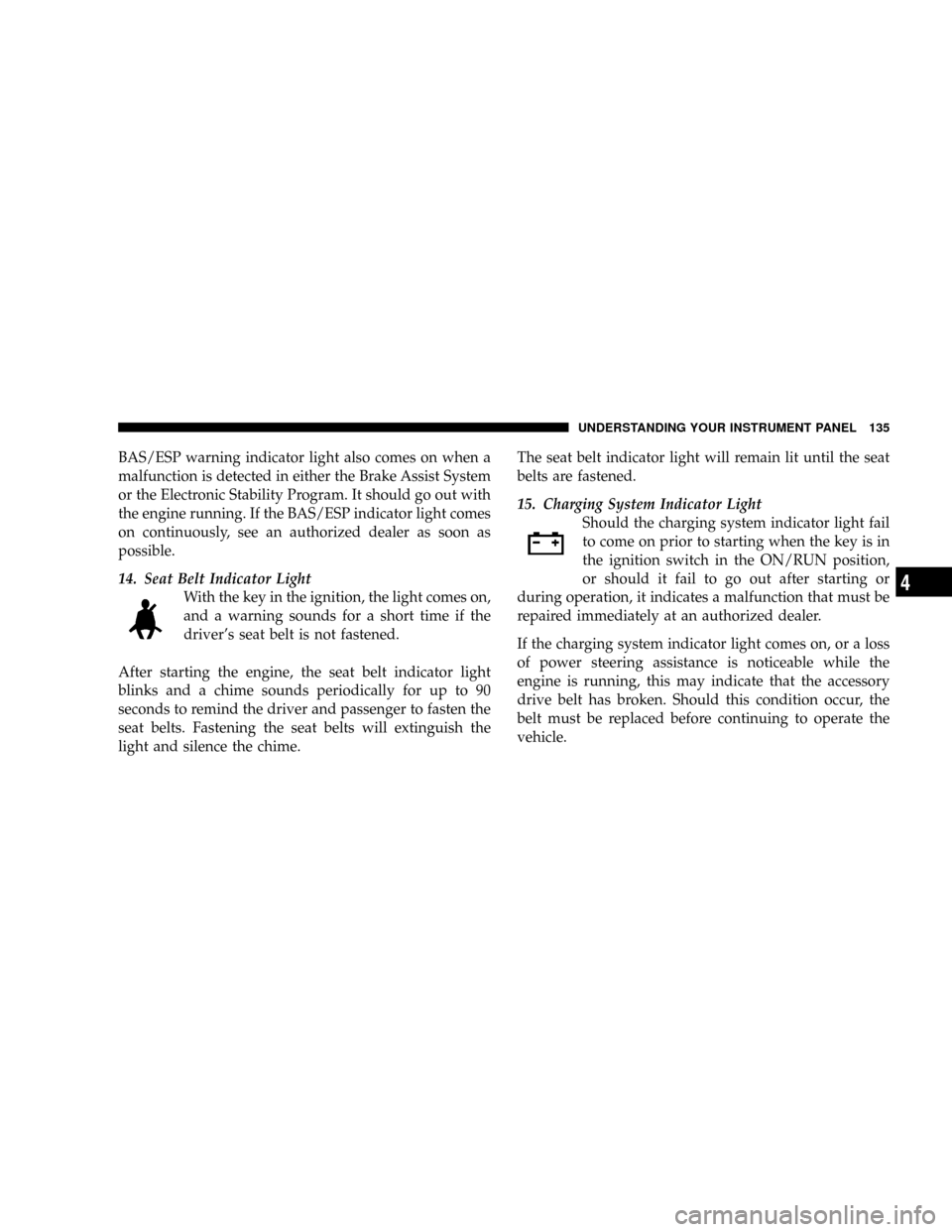
BAS/ESP warning indicator light also comes on when a
malfunction is detected in either the Brake Assist System
or the Electronic Stability Program. It should go out with
the engine running. If the BAS/ESP indicator light comes
on continuously, see an authorized dealer as soon as
possible.
14. Seat Belt Indicator Light
With the key in the ignition, the light comes on,
and a warning sounds for a short time if the
driver's seat belt is not fastened.
After starting the engine, the seat belt indicator light
blinks and a chime sounds periodically for up to 90
seconds to remind the driver and passenger to fasten the
seat belts. Fastening the seat belts will extinguish the
light and silence the chime.The seat belt indicator light will remain lit until the seat
belts are fastened.
15. Charging System Indicator Light
Should the charging system indicator light fail
to come on prior to starting when the key is in
the ignition switch in the ON/RUN position,
or should it fail to go out after starting or
during operation, it indicates a malfunction that must be
repaired immediately at an authorized dealer.
If the charging system indicator light comes on, or a loss
of power steering assistance is noticeable while the
engine is running, this may indicate that the accessory
drive belt has broken. Should this condition occur, the
belt must be replaced before continuing to operate the
vehicle.
UNDERSTANDING YOUR INSTRUMENT PANEL 135
4
Page 138 of 358
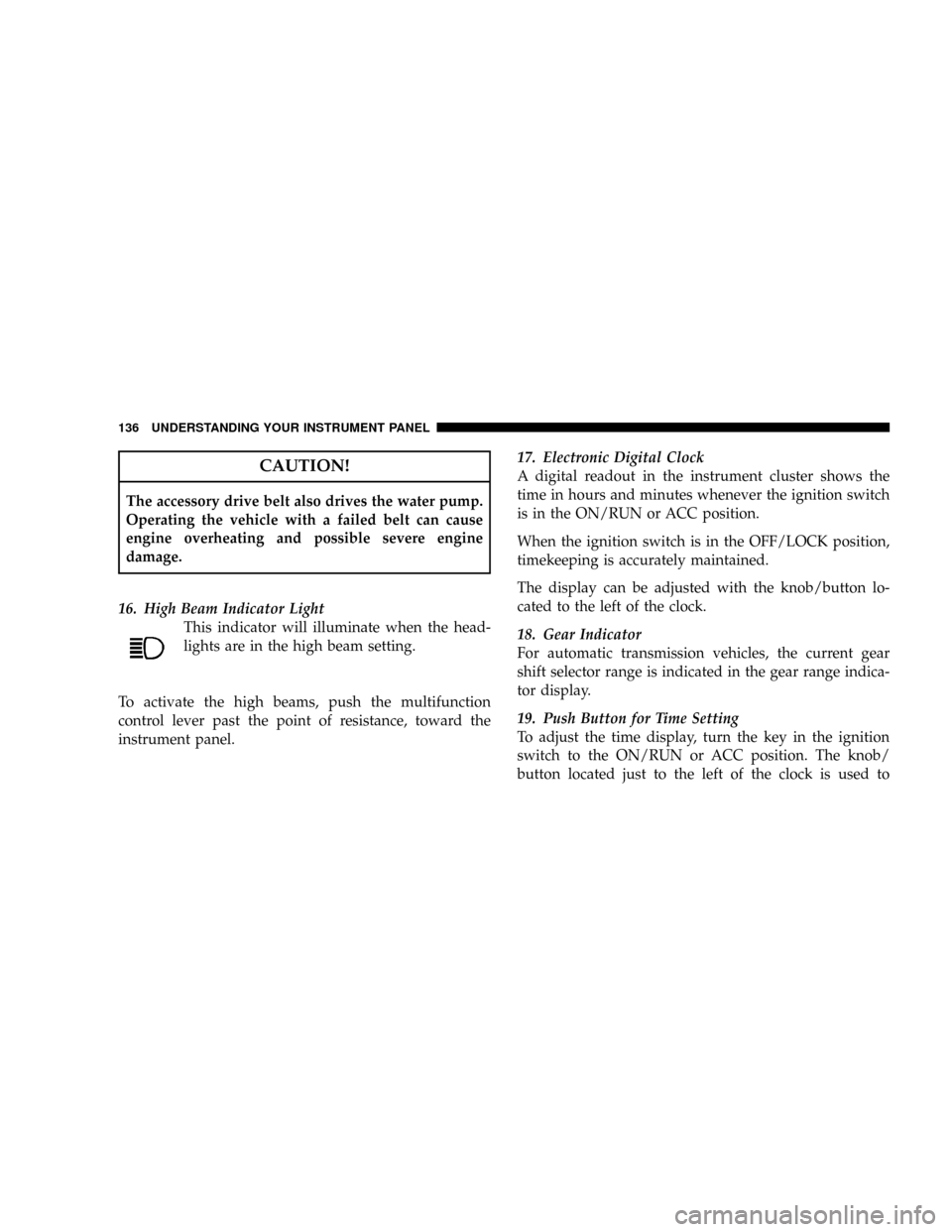
CAUTION!
The accessory drive belt also drives the water pump.
Operating the vehicle with a failed belt can cause
engine overheating and possible severe engine
damage.
16. High Beam Indicator Light
This indicator will illuminate when the head-
lights are in the high beam setting.
To activate the high beams, push the multifunction
control lever past the point of resistance, toward the
instrument panel.17. Electronic Digital Clock
A digital readout in the instrument cluster shows the
time in hours and minutes whenever the ignition switch
is in the ON/RUN or ACC position.
When the ignition switch is in the OFF/LOCK position,
timekeeping is accurately maintained.
The display can be adjusted with the knob/button lo-
cated to the left of the clock.
18. Gear Indicator
For automatic transmission vehicles, the current gear
shift selector range is indicated in the gear range indica-
tor display.
19. Push Button for Time Setting
To adjust the time display, turn the key in the ignition
switch to the ON/RUN or ACC position. The knob/
button located just to the left of the clock is used to
136 UNDERSTANDING YOUR INSTRUMENT PANEL
Page 139 of 358
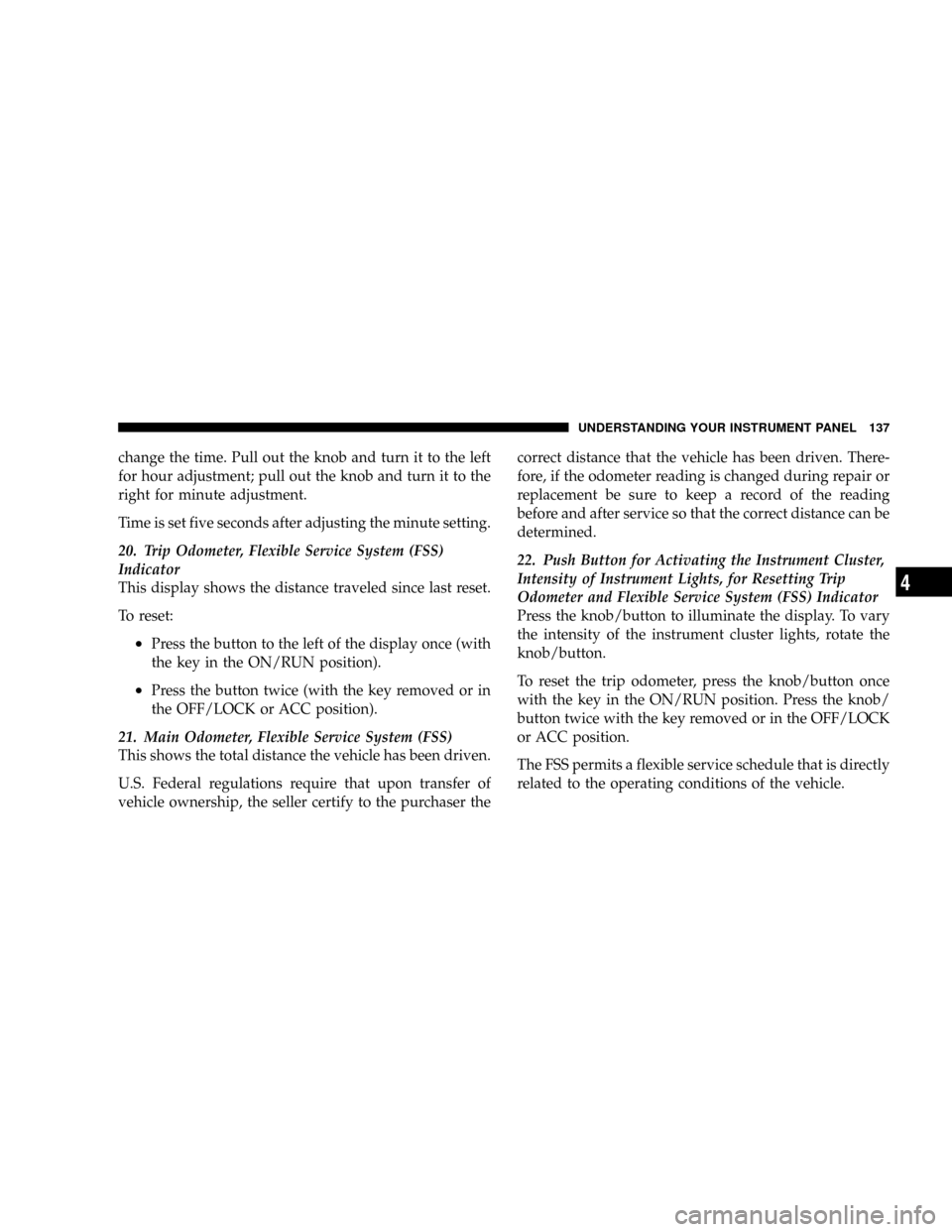
change the time. Pull out the knob and turn it to the left
for hour adjustment; pull out the knob and turn it to the
right for minute adjustment.
Time is set five seconds after adjusting the minute setting.
20. Trip Odometer, Flexible Service System (FSS)
Indicator
This display shows the distance traveled since last reset.
To reset:
²Press the button to the left of the display once (with
the key in the ON/RUN position).
²Press the button twice (with the key removed or in
the OFF/LOCK or ACC position).
21. Main Odometer, Flexible Service System (FSS)
This shows the total distance the vehicle has been driven.
U.S. Federal regulations require that upon transfer of
vehicle ownership, the seller certify to the purchaser thecorrect distance that the vehicle has been driven. There-
fore, if the odometer reading is changed during repair or
replacement be sure to keep a record of the reading
before and after service so that the correct distance can be
determined.
22. Push Button for Activating the Instrument Cluster,
Intensity of Instrument Lights, for Resetting Trip
Odometer and Flexible Service System (FSS) Indicator
Press the knob/button to illuminate the display. To vary
the intensity of the instrument cluster lights, rotate the
knob/button.
To reset the trip odometer, press the knob/button once
with the key in the ON/RUN position. Press the knob/
button twice with the key removed or in the OFF/LOCK
or ACC position.
The FSS permits a flexible service schedule that is directly
related to the operating conditions of the vehicle.
UNDERSTANDING YOUR INSTRUMENT PANEL 137
4
Page 140 of 358
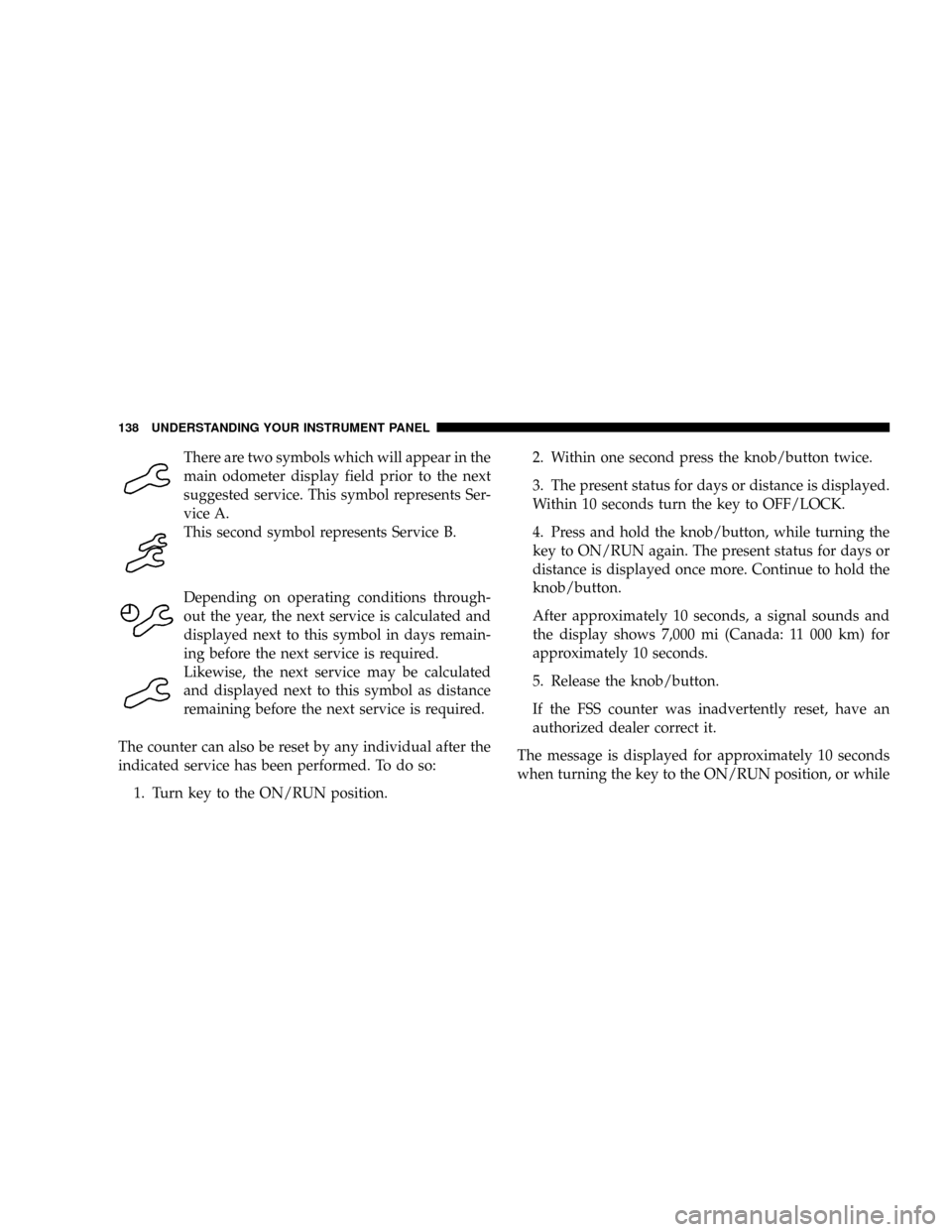
There are two symbols which will appear in the
main odometer display field prior to the next
suggested service. This symbol represents Ser-
vice A.
This second symbol represents Service B.
Depending on operating conditions through-
out the year, the next service is calculated and
displayed next to this symbol in days remain-
ing before the next service is required.
Likewise, the next service may be calculated
and displayed next to this symbol as distance
remaining before the next service is required.
The counter can also be reset by any individual after the
indicated service has been performed. To do so:
1. Turn key to the ON/RUN position.2. Within one second press the knob/button twice.
3. The present status for days or distance is displayed.
Within 10 seconds turn the key to OFF/LOCK.
4. Press and hold the knob/button, while turning the
key to ON/RUN again. The present status for days or
distance is displayed once more. Continue to hold the
knob/button.
After approximately 10 seconds, a signal sounds and
the display shows 7,000 mi (Canada: 11 000 km) for
approximately 10 seconds.
5. Release the knob/button.
If the FSS counter was inadvertently reset, have an
authorized dealer correct it.
The message is displayed for approximately 10 seconds
when turning the key to the ON/RUN position, or while
138 UNDERSTANDING YOUR INSTRUMENT PANEL